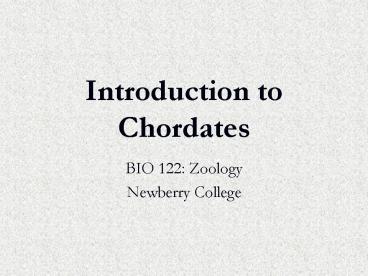Introduction to Chordates - PowerPoint PPT Presentation
1 / 29
Title:
Introduction to Chordates
Description:
Introduction to Chordates BIO 122: Zoology Newberry College Phylum Chordata Most complex of all phyla All have a notochord rod-like semirigid body of cells usually ... – PowerPoint PPT presentation
Number of Views:443
Avg rating:3.0/5.0
Title: Introduction to Chordates
1
Introduction to Chordates
- BIO 122 Zoology
- Newberry College
2
Phylum Chordata
- Most complex of all phyla
- All have a notochordrod-like semirigid body of
cellsusually extends length of bodyventral to
nervous systems spine - Purposes1) support stiffen body2) provide
skeletal support for muscles
3
Phylum Chordata
- Five important features of chordates
- Notochord
- Dorsal tubular nerve cord
- Pharyngeal pouches and gill slits
- Endostyle
- Postanal tail
4
Chordate characteristics
- 1) Notochord - a flexible, rod-like structure
beginning of the internal skeleton axis for
muscle attachment, flexible w/o shortening
in vertebrates the notochord becomes segmented
as vertebrae
5
Chordate characteristics
- 2) Dorsal Tubular Nerve Cord - produced by
infolding of ectoderm during early development
in many invertebrates the nerve cord is
ventral and solid in many anterior end becomes
swollen brain
6
Chordate characteristics
- 3) Pharyngeal Pouches and Gill Slits - perforated
openings lead from pharyngeal cavity to outside
body in simplest aquatic chordates it allows
for suspension feeding in terrestrial
organisms is only developmental
7
Chordate characteristics
- 4) Endostyle - or its derivative, the thyroid
gland in the simplest chordates the endostyle
secretes mucus that traps small food particles
8
Chordate characteristics
- 5) Postanal Tail - extension of body beyond
anus enhances ability for movement (aquatic)
balance (terrestrial)
9
Additional Chordate Features
- Development pattern as in Echinoderms radial,
indeterminate cleavage deuterostome
enterocoelous - Segmented muscles in an unsegmented body
- Complete digestive system
- Closed circulatory system
- Endoskeleton made of cartilage and/or bone
10
Classification of Chordates
- Three distinct SubphylaUrochordata
tunicatesCephalochordata lanceletsVertebrata
- vertebrates
11
Subphyla of Chordates
- SUBPHYLUM UROCHORDATA - tunicates
- Only larval form moves, adults are sessilelarvae
with all chordate characteristics - Adults relatively small, up to a few cm long
produce a leathery outer surface ( tunic) loss
of notochord tail, nerve cord greatly reduced
become filter feeders with siphons gills slits
become net-like to trap food - Individuals are hermaphroditic reproductive
cells into water, external fertilization
12
Diagramatic tunicate
13
Subphyla of Chordates
- SUBPHYLUM CEPHALOCHORDATA - lancelets
- Slender, lancet-shaped, 5-7 cm long sandy
bottoms of shallow marine environments - Adults clearly with all the chordate
characteristics suspension feeders, trap food
in gills slits circulatory system closed, but
no distinct heart no obvious brain - Separate males and females fertilization
external
14
Diagramatic lancelet
15
Subphyla of Chordates
- SUBPHYLUM VERTEBRATA - vertebrates
- Very large and diverse groupwell known due to
large size - Not all chordatefeatures in adults
16
Characteristics of Vertebrates
- Expanded endoskeleton - living endoskeleton
internal skeleton, grows with the organism
commonly is hollow, provides support
distinctive covering around brain cranium
17
Characteristics of Vertebrates
- Gills in pharynx - better respiration other
subphyla use slits for filter feeding more
active aquatic vertebrates developed gills
with muscles heart developed to enhance
circulation
18
Characteristics of Vertebrates
- Enhanced Nervous System with anterior
swelling more complex behaviors of swimmers
predators has tripartite brain (fore-, mid-
and hind-brain) development of enhanced senses
19
Characteristics of Vertebrates
- Development of neural crest ectodermal placode
enhances complexity neural crest enhances
development of skeleton, tooth dentine
endocrine glands ectodermal placodes enhance
sensory development (olfactory, eye, ear)
20
CLASSIFICATION OF VERTEBRATES
- Several important characteristics to separate1)
skeleton jaw composition cartilage or bony2)
number structure of paired appendages3) dermal
covering over body4) relative number of gill
slits of an adult5) type of covering over egg
21
CLASSIFICATION OF VERTEBRATES
- SUPERCLASS AGNATHA lampreys hagfishcartilagino
us skeleton and no jawno paired appendagesskin
smooth (slimy)about 7 gill slits per sideeggs
with gelatinous covering (aquatic)heart
2-chambered (1 atrium 1 ventricle)
22
SUPERCLASS AGNATHA
- Lamprey (note gill slits)
23
CLASSIFICATION OF VERTEBRATES
- SUPERCLASS GNATHOSTOMATA All other vertebrates
with jaws paired appendages
24
CLASSIFICATION OF VERTEBRATES
- Class Chondrichthyes (sharks rays)
- cartilaginous skeleton and jaw present
- 2 pair fins
- placoid scales (tooth like with root)
- 5-7 pair gill slits
- eggs with gelatinous covering (aquatic)
25
CLASSIFICATION OF VERTEBRATES
- Class Actinopterygii (bony ray-finned fish)
- bony skeleton, jaw present
- 2 paired appendages fins
- overlapping dermal scales (typically thin
flexible) - gill slits with covering operculum
- egg covering gelatinous
26
CLASSIFICATION OF VERTEBRATES
- Class Amphibia (amphibians)
- bony skeleton, jaw present
- 2 paired appendages, legs
- smooth skin
- gills only in juvenile forms
- eggs with gelatinous covering (aquatic)
27
CLASSIFICATION OF VERTEBRATES
- Class Reptilia (reptiles)
- bony skeleton, jaw present
- 2 paired appendages, legs
- hard scales (snakes) or plates (turtles)
- gills embryonic only
- eggs with leathery covering (terrestrial)
28
CLASSIFICATION OF VERTEBRATES
- Class Aves (birds)
- bony skeleton, jaw present
- 2 paired appendages legs wings
- feathers scales on legs
- gills embryonic only
- eggs with calcified shell (terrestrial)
29
CLASSIFICATION OF VERTEBRATES
- Class Mammalia (mammals)
- bony skeleton, jaw present
- 2 paired appendages legs ( arms)
- fur and/or hair
- gills embryonic only
- viviparous (few with calcified shells)































